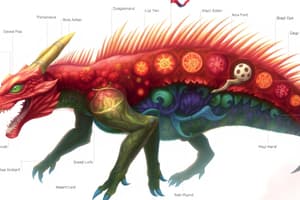Podcast
Questions and Answers
What is written correctly?
What is written correctly?
- "One particular name can be used only for one taxon". It means ... (correct)
- "the earliest name should be used". Law of ...
What is not the right order?
What is not the right order?
- Classification of organisms on the basis of their overall similarity is ... (correct)
- "Binomial system" is based on ...
Whittaker recommended ... kingdoms
Whittaker recommended ... kingdoms
- Geographical isolation: they show morphological differences but can still exchange genes when they meet and mate". (correct)
- The modern science of classification is called ...
Which is not taxonomic category?
Which is not taxonomic category?
Which order does the genus Trypanosoma belong to?
Which order does the genus Trypanosoma belong to?
Which order does the genus Leishmania belong to?
Which order does the genus Leishmania belong to?
Which order does the genus Giardia belong to?
Which order does the genus Giardia belong to?
Which does not have a cyst?
Which does not have a cyst?
Which has a cyst?
Which has a cyst?
Which is the most important genus of the coccidia without cyst formation?
Which is the most important genus of the coccidia without cyst formation?
Which genus belongs to cystogenic coccidia?
Which genus belongs to cystogenic coccidia?
Which is the most important genus of haemosporinids?
Which is the most important genus of haemosporinids?
Which is the most important genus of protoplasms?
Which is the most important genus of protoplasms?
Which develops also in blood-sucking arthropod vector?
Which develops also in blood-sucking arthropod vector?
Which group is the most closely related to cnidarians?
Which group is the most closely related to cnidarians?
In which class is the medusa stage absent?
In which class is the medusa stage absent?
In which class is the polyp stage sometimes absent?
In which class is the polyp stage sometimes absent?
In which class is the budding of the polyp stage terminal?
In which class is the budding of the polyp stage terminal?
What is the approximate number of species in phylum plathelminthes?
What is the approximate number of species in phylum plathelminthes?
Which category do flatworms belong to?
Which category do flatworms belong to?
What kind of gut do cestodes have?
What kind of gut do cestodes have?
Where does coracicium develop?
Where does coracicium develop?
In which category is the six-hooked Taenia oncosphere the first stage larva?
In which category is the six-hooked Taenia oncosphere the first stage larva?
How many ovaries does an adult Taenia usually have?
How many ovaries does an adult Taenia usually have?
In which class is there pseudocoelome (primary, false body cavity)?
In which class is there pseudocoelome (primary, false body cavity)?
Males of which group have always copulatory bursa?
Males of which group have always copulatory bursa?
Approx. how many described species do nematodes have?
Approx. how many described species do nematodes have?
What is the approx. number of nematodes significant from the veterinary point of view?
What is the approx. number of nematodes significant from the veterinary point of view?
Into which category does the largest species of the following groups belong to?
Into which category does the largest species of the following groups belong to?
What can be found in the buccal capsule of nematodes?
What can be found in the buccal capsule of nematodes?
Where does Lumbricus terrestres belongs to?
Where does Lumbricus terrestres belongs to?
What is the characteristic of Lumbricus terrestis?
What is the characteristic of Lumbricus terrestis?
What kind of feeding apparatus may leeches have?
What kind of feeding apparatus may leeches have?
In which categories can the absence of shell be observed?
In which categories can the absence of shell be observed?
Where does the probably most intelligent invertebrate belong to?
Where does the probably most intelligent invertebrate belong to?
Where do sac animals (sea-squirts) belong?
Where do sac animals (sea-squirts) belong?
What is the characteristic of phylum Hemichordata?
What is the characteristic of phylum Hemichordata?
Where do hagfish belong?
Where do hagfish belong?
Where do lampreys belong?
Where do lampreys belong?
Which fin can be regarded as a limb (extremity)?
Which fin can be regarded as a limb (extremity)?
Which is the most ancient type of scales (characteristic of Chondrichthyes)?
Which is the most ancient type of scales (characteristic of Chondrichthyes)?
What kind of body covering do actinopterygians have?
What kind of body covering do actinopterygians have?
What kind of body covering do elasmobranchs have?
What kind of body covering do elasmobranchs have?
Flashcards
Taxonomy
Taxonomy
The science of classifying organisms based on their shared characteristics.
Binomial nomenclature
Binomial nomenclature
A system for naming organisms using two words: the genus and the species. For example, Homo sapiens is our scientific name.
Taxonomic rank
Taxonomic rank
Different levels of classification used to organize life, starting from the broadest category (Domain) and getting more specific (Species).
Phylogenetic relationships
Phylogenetic relationships
Signup and view all the flashcards
Morphology
Morphology
Signup and view all the flashcards
Physiology
Physiology
Signup and view all the flashcards
Development
Development
Signup and view all the flashcards
Anatomy
Anatomy
Signup and view all the flashcards
Reproduction
Reproduction
Signup and view all the flashcards
Feeding
Feeding
Signup and view all the flashcards
Body structures
Body structures
Signup and view all the flashcards
Ecological roles
Ecological roles
Signup and view all the flashcards
Species
Species
Signup and view all the flashcards
Genus
Genus
Signup and view all the flashcards
Taxa
Taxa
Signup and view all the flashcards
Scientific name
Scientific name
Signup and view all the flashcards
Law of Priority
Law of Priority
Signup and view all the flashcards
Homonym
Homonym
Signup and view all the flashcards
Cestode
Cestode
Signup and view all the flashcards
Category
Category
Signup and view all the flashcards
Clade
Clade
Signup and view all the flashcards
Evolution
Evolution
Signup and view all the flashcards
Adaptation
Adaptation
Signup and view all the flashcards
Phylum
Phylum
Signup and view all the flashcards
Ecology
Ecology
Signup and view all the flashcards
Ethology
Ethology
Signup and view all the flashcards
Flatworm
Flatworm
Signup and view all the flashcards
Roundworm
Roundworm
Signup and view all the flashcards
Polyphyletic
Polyphyletic
Signup and view all the flashcards
Monophyletic
Monophyletic
Signup and view all the flashcards
Study Notes
Correct Taxonomic Naming
- The earliest name should be used, per the Law of Priority.
- One particular name can only be used for one taxon.
Incorrect Taxonomic Order
- The binomial system is based on the classification of organisms based on similar characteristics.
- Whittaker recommended kingdoms as a classification.
- Geographical isolation shows morphological differences, but species can still exchange genes if they meet and mate.
- Evolutionary classifications are different from standard taxonomy.
Taxonomic Categories
- Order: A taxonomic rank above Family, and below class
- Class: A taxonomic rank above Order, and below Phylum
- Order/class/subphylum: is a taxonomic rank of one name, used in evolutionary cladistics
- Species/genus/family: uses 2 names and observed in evolutionary systematics
- Subspecies: a taxonomic rank of organisms; (a rank below species) (used in phenotypic classifications)
- Biospecies: a taxonomic rank used in classifications including biological systematics
- Breed: is a taxonomic classification used in zoology
- Species: taxonomic rank in biology
Additional Taxonomic Information
- Phenetics: A method of classification based on the degree of overall similarity between organisms.
- Cladistics: A classification method based on evolutionary relationships and branching patterns.
- Homonyms: Multiple names for a single species can not be used, the earliest should be used.
- Priority: in nomenclature, the first named taxa has naming priority
- Stability: in nomenclature, using the same name for the same taxa
- Scientific nomenclature: rules for scientific naming of organisms
- Muscidae: A taxonomic order (Insects)
- Musca domestica: A taxonomic species (House fly)
Phylogenetic Relationships (Based on Provided Questions)
- Trypanosoma: belong to a specific order (not specified)
- Leishmania: belong to a specific order (not specified)
- Giardia: belong to a specific order (not specified)
- Emeria: does not have a cyst but many other genera do
- Cystogenic coccidia: genus not found
- Haemosporinids: genus not found
- Piroplasms: genus not found
- Cnidarians: organisms mentioned are related
Categorizations and Characteristics
-
Flatworms (Platyhelminthes): A large phylum of invertebrates.
-
Cestodes: flatworms with a characteristic lack of a gut and no feeding structures
-
Trematodes: parasitic flatworms with a gut
-
Nematodes: roundworms, have different feeding methods.
-
Guts: Some have one-branched; others have two-branched blind endings, three-branched guts
-
Ovaries: Adult tapeworms have multiple ovaries
-
Pseudocoelomates: have a body cavity
-
Copulatory bursa: males feature such structures in some nematodes
-
Lumbricus terrestris: an earthworm
- Characteristics: details not specified, but characteristics are noted
-
Feeding apparatuses: Leech feeding methods are noted but details not explicitly mentioned
-
Invertebrate intelligence: Cephalopods, mentioned as possibly the most intelligent invertebrates noted.
Organisms with Particular Structures
- Sea squirts (Hemichordata): Have specific characteristics for their phylum.
- Hagfish: are described to have specific characteristics
- Lampreys: are described to have specific characteristics
- Chondrichthyes (Cartilaginous fishes): have characteristics including teeth, fin types, and body cover.
- Actinopterygii (Ray-finned fishes): have specific characteristics including teeth, fin types, body cover.
Additional Information
-
Number of species: (inferred from the questions), such as nematodes, and other organisms are mentioned
-
Specific details on organisms have been mentioned in the questions such as taxonomic classification and characteristics.
Studying That Suits You
Use AI to generate personalized quizzes and flashcards to suit your learning preferences.




